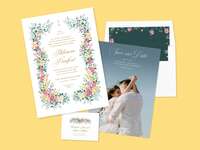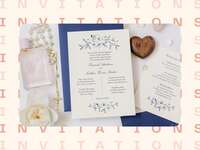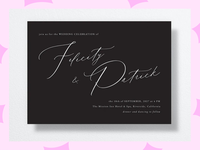Everything You Need to Know About Bilingual Wedding Invitations
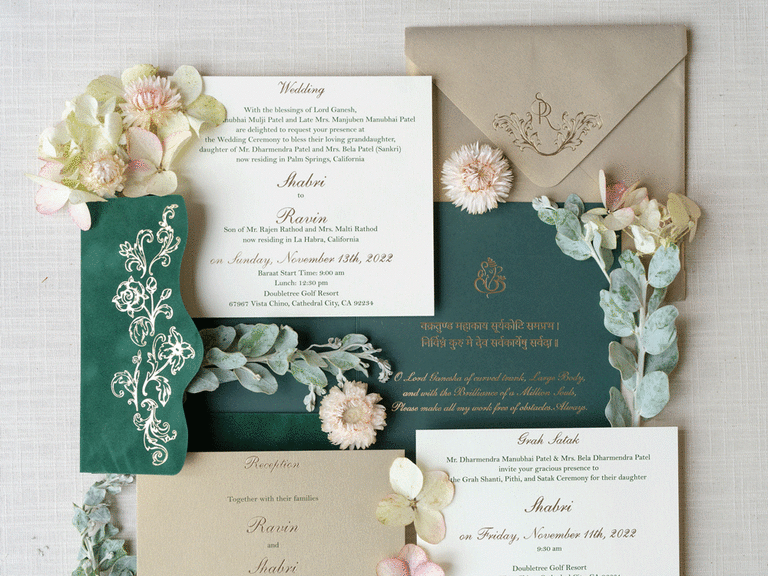
One of the best parts of having a wedding is that you get to celebrate your and your partner's love with your friends and family. And the first step in making that happen is sending out wedding invitations. But if English isn't some or a lot of your wedding guests' first language, bilingual wedding invitations are the perfect solution for you. They allow you to communicate with your guests and make them feel included while showing appreciation for your and your partner's culture. If you don't know how to start making your dual-language wedding suite, read these helpful wedding invitation tips from bilingual wedding experts.
The Pros of Having Bilingual Wedding Invitations
Wedding invitation wording is important because it tells your guests what to expect for the big day. Check out the benefits of having dual-language wedding invitations below.
You're showing respect to your guests.
Having bilingual wedding invitations is a thoughtful gesture to your guests that don't speak English. It shows that you care about every guest understanding and enjoying your wedding details. "Bilingual invitation suites are a great way to show respect for the respective cultures of the couple," Joyce Lee, owner of Showcase Your Style Event Planning, LLC says. Lee speaks to bilingual wedding invitations' importance for older guests. "Also, sometimes there are elders in the family who don't understand the English language and prefer to receive an invitation in their native language."
You're honoring your culture.
Dual-language wedding invitations allow you to showcase your and your partner's cultures. "You're honoring your culture by not leaving behind your language even if it's not predominantly spoken in the place you're getting married at," Maria Ferrer, owner of Orchid Studio, says. And don't worry, it doesn't matter if you're not bilingual or fluent in the language because the invitations will make you appreciate your heritage even more.
They set guest expectations.
If you're planning on having a bilingual or multicultural wedding, sending out bilingual wedding invitations makes perfect sense. The invitations let your guests know your wedding is blending two cultures, which is a great way to set the tone before the big day. This sets the foundation for your guests understanding and being more appreciative of your and your partner's cultures on the wedding day.
They save you money.
Bilingual wedding invitations help you avoid sending special invitations to your non-English speaking guests. When ordering invitations, it's best to do one large order where all the invitations have the same design and wording. This is because you don't have to worry about invitation order minimums. Plus, many wedding invitation sellers offer good prices with the more invitations you order (versus you making two separate orders of differing sizes).
The Cons of Having Bilingual Wedding Invitations
Even though there are a lot of pros to bilingual wedding invitations, there are a few inconveniences you should know about. Understanding the potential drawbacks will allow you and your partner to make the best decision for both of you.
All your details can't fit on one invitation.
Unfortunately, writing your wedding details in two languages can make your invitations too wordy. Putting one language on the front of the invitation and another on the back can solve the problem, but there is a chance your guests might not check the back of the invitation. Also, since bilingual wedding invitations are text-heavy, you'll be forced to keep your suite design simple to help fit all your wedding details.
You'll need a trusted writer (and proofreader).
If you're not fluent in the non-English language you're planning to include, you'll need someone to write your invitations. We suggest you ask a fluent friend, family member or hire a bilingual wedding invitation designer instead of using Google Translate or another online translation tool. Google Translate can be a wonderful help for simple phrases, but not for important tasks like your wedding invitations since not every word can be translated exactly the way you mean it.



It doesn't matter whether you or your partner are bilingual, you need to have a native speaker proofread your dual-language invitations. If you're considering sending your invitation to a stationery designer that doesn't speak one of the languages, Lee says a proofreader is especially important. "Sometimes people choose to order from overseas for styling preference. At that point, the couple needs to proofread the English portion of the invitation because they may be dealing with a non-English speaker who doesn't know English invitation wording enough to know if they've made a mistake," Lee explains.
It can add more time and effort.
Figuring out how to fit all your wedding details in two languages onto one invitation and finding a native speaker to help with your wedding invitation wording can understandably be more time and effort than you and your partner want to invest. We suggest you and your partner make a list of all the wedding guests who don't speak English. If it's only a few people, you should order invitations in their language specifically for them, but if half or the majority of your guests need a second language invitation, you should make all your invites bilingual. You want to ensure your guests feel included in your wedding, so try your best to do that every step of the way, even when for the stationery.
The Best Layouts for Bilingual Wedding Invitations
Ensuring all of your wedding information fits on an invitation is already difficult (there's always so much to say) and including two languages makes it a little more complicated. We asked Shreya, founder and CEO of VS Invitations, what the best layouts are for creating a bilingual wedding invitation design. Let the ideas below inspire you.
Double-sided: Shreya suggests having one language per side of the invitation. It doesn't matter which language you put on what side as long as the wedding details match.
-
Side-by-side: Put the two different languages on the same invitation, each language on each side (left and right) of the invitation. "This format will ensure that all guests understand key details. Plus, it'll be fun for your guests to experience another language and learn a few new words," Shreya explains.
Top to bottom: Have one language on the top and the second underneath it.
Add an insert: Add a small insert with one of the languages on it, so you don't have to try to fit both languages on one invite.
Bilingual Wedding Invitation Wording for Specific Languages and Cultures
The formatting of the invitation can be vastly different depending on the language and the culture. Below is a list of a few ways you can have an authentic Chinese, Spanish or Indian wedding invitation.
Chinese Wedding Invitations

"The Chinese invitation language tends to be very formal, and a lot of the wording isn't commonly used in everyday life. For example, they like to list out the year and date in the Chinese calendar in addition to the Western calendar," Lee says. "While you can find the wordings online, I highly recommend still having someone who's an expert in the language proofread your invitation before it goes to print," Lee adds. Also, it's typical for Chinese wedding invitations to be red or in red envelopes, a color associated with success, honor and love, and include a double happiness character.
Spanish Wedding Invitations
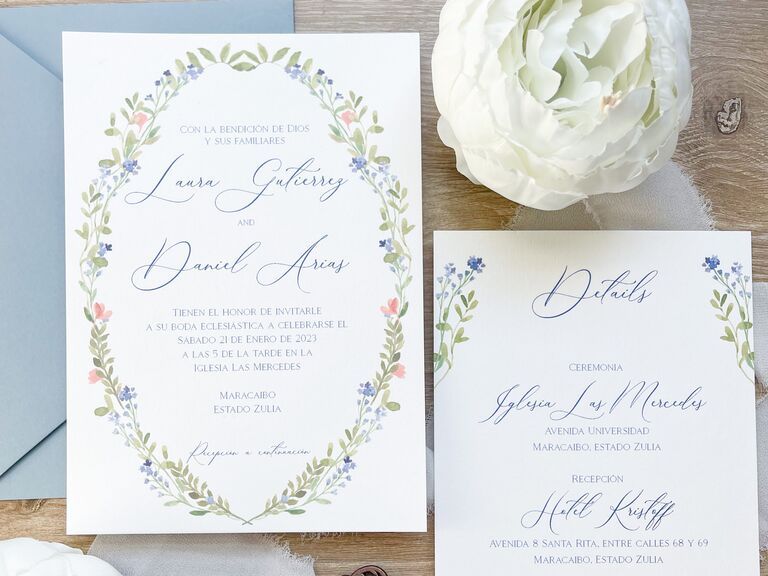
"For bilingual wedding invitations in Spanish and English, I believe structurally, they're basically the same because the same information needs to be displayed. The difference comes based on where the wedding will be because rules of etiquette may vary depending on the country and the culture, which can affect the type and quantity of information included on the invitation," Ferrer says. Ferrer also wants couples to know that they should keep spacing in mind when doing a dual-language wedding invitation. "I personally only have experience translating from English to Spanish, Spanish is my native language, and my only recommendation is to try to keep [the wording] as simple as possible. In Spanish, you use more words than in English, which can easily make the design look too busy."
Indian Wedding Invitations
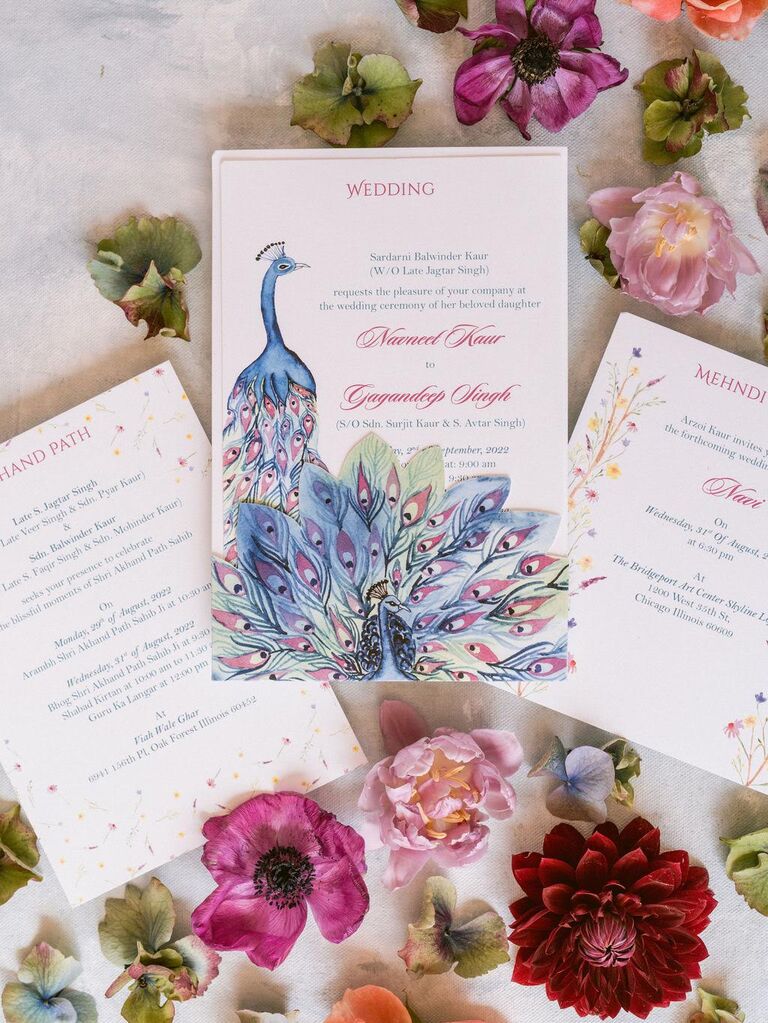
For Indian wedding invitations, the placement of the couple's name and other names depends on various factors. Traditionally, the couple's parents' (or grandparents') names go under the couple's names. For example, "Daughter of [Parent Name] and [Other Parent Name]" is how it would be written underneath the bride's name. Shreya says it's customary to put the educational qualifications under the couple's names as well. Finally, when writing the couple's names on the invitation, whose name goes first depends on which side of the family sent the invitations. If the couple sent the invitations together, the couple's names are listed side by side.




